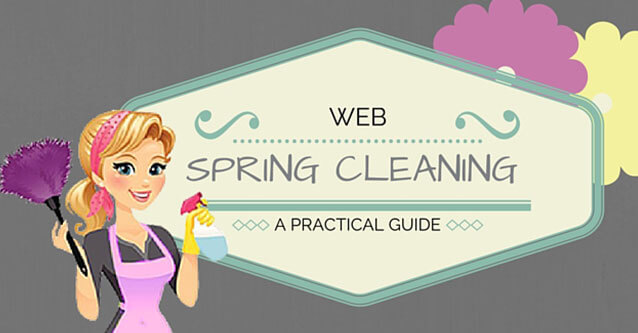Spring cleaning your web assets

Finally winter is starting to come to an end and the prospect of spring is lifting moods and promising renewal. For me this has been a long winter, and one that I am glad to see the back of. Of course I ate too much and I will probably have to nearly kill myself all of spring to undo the damage I did, but nonetheless I am full of hope, enthusiasm and excitement about what summer will bring. I am also looking forward to assessing what I am happy with and what not so I can work out my priorities for the next few months on both personal and professional levels. I find myself already making summer resolutions, so I thought I’d share one of them here and now before I get bogged down again and it becomes another of my to-do items on a never-ending list.
As one of the owners of a digital agency in Melbourne, I see a lot of online mishaps start-up and small businesses make when entering the online arena. Like many mistakes in life, most are completely preventable or avoidable and is probably made simply because these business owners did not have the right information when having to make crucial decisions. So instead of just shaking my head in silence as I’ve always done, I am now speaking up, purely based on my own personal experiences. So sit up and indulge me for a moment or two – I really believe what I am sharing here are useful and practical tips if you are doing some online asset spring cleaning and want to set your business scene for summer.
Find an agency who gives a crap
A large percentage of our work comes from fixing up websites that were coded poorly, were never completed or do not meet the requirements set by the client. That is so disappointing. Like there are good and bad hairdressers, you will find good and bad web developers. And like in any industry, there are a few rotten apples around that will try and take advantage of you at every opportunity they get. I recently had a bad experience at a garage where the mechanic tried to sell me tyres I simply did not need, purely because I was a female on my own making the enquiry. You have to steer clear of these vultures in the online industry, and there are a few practical steps you can take to protect yourself from falling into the wrong hands:
- Ask around for recommendations. If someone you know are willing to vouch for a designer or developer, start your enquiries there.
- Ask for testimonials and to speak to existing clients. Most agencies showcase their clients on their websites, so ask the agency if you can pick one or 2 of their clients to speak with. This has more value than speaking to someone the agency nominates – of course they will put forward who they believe will give the best review.
- Review their previous work. If they have examples of past work you like you are more likely to get the result you are after.
- Get to know them. Nowadays most agencies advertise online, and you will find lots of information in social media and other advertising media. Review what the agency says in blogs, on Facebook, Twitter etc and establish what they stand for.
What you should be looking for is an agency that is aligned with your values, and who will have your best interests at heart. They should measure their success by how they help you grow your business online, and not by how long their client list is. Having the right online partner can make or break your business, especially because websites – for most businesses – have become the first point of contact with customers, and – like in real life – first impressions still count. So – where logistics allow – meet with any developers you shortlist and make sure you can trust them with representing your business well online. Utilise Skype to meet teams online – distance should not be a barrier in today’s day and age.
And a side note on fees: price should definitely not be your main consideration and remember that you normally get exactly what you pay for. The right online partner will give you return on investment, period. I’m not saying that there is a direct correlation between fees and quality of service, but in my experience, the cheapest ones are charging less or discounting fees for a reason. If you are offered a discount, ask why you are getting it. Up to you to decide whether it is legit.
Start at the beginning
You are your brand and your brand is everything.
That about sums it up. If you are in the setup phase of your business, your business name and brand mark should be where your journey starts. A lot of businesses re-brand later down the track, and in my opinion this is often the result of them not paying enough attention to this all important first step when setting up. Sure, we are all excited and full of beans when starting out, and with the amount of work to do it is natural that you want to get it all done and get it done quickly. However, I urge you to take a breath and spend some time on formulating a brand that represents you and what you are building. You have got to be proud of your logo and you should be the first one in a room full of strangers who will start handing out business cards, purely because you want to show off your branding. Make sure your business’ vision and mission are encapsulated in your brand. It is so much easier for you to stay true and for customers to remain loyal to a brand they love and associate with, so aim to be remarkable. ‘Just getting something up’ when you start up is not good enough, and will cause a lot of extra work and cost when you need to re-brand in future plus you risk confusing or even losing existing brand followers.
Know your market
Before starting your website or any other online marketing efforts it is crucial that you have a clear understanding of who you will be targeting. You have to have clear goals, so you can measure success and learn from mistakes. Identify your target groups early, so your website and online campaigns can be tailored to talk directly to them, giving you the best chance of meeting your goals. Once you know your market it is easy to identify common characteristics and needs, and establish the best ways of reaching them. So forget about blanket marketing and hoping for the best – those days are long gone.
Measure and learn
Ever heard of Google Analytics and Webmaster Tools? Very cool tools to help you understand any issues with your existing website, what users do on your website, what works and what doesn’t. And the best part is, it is free! If you do not already have this on your website, seriously, wake up and smell the roses! Get someone to install this straight away. Admittedly fine-tuning the installation, setting up goals and events, and interpreting results can be a bit techie, but if you have found the perfect partner I touched on earlier in this article, they will no doubt be able to assist you with this. We often do the basic setup free of charge since this simple service provides the statistics to illustrate to a client the value we can bring to their business. And we are not alone with this approach. Once you have oversight of your current website you can identify areas for improvement and incorporate that into any future web projects you are planning. It will also help you prioritise the need for a new website, so you can budget and plan accordingly.
Marketing on a budget
One of the biggest challenges when starting up is getting your name, your product or your service out there. It is challenging letting the whole world know that you are ready and open for business, and most of the time you are so strapped for cash that plunging into full-on marketing is simply not an option. So my advice here is to start with social media marketing. Again, your web partner has a vital role to play here if you have no experience in this area, but it is also not rocket science and something you could try yourself if you have a bit of spare time to learn the ropes. However you go about this, it is an excellent start.
In my own personal experience, social advertising has always produced leads and/or clients for us, so it is getting a big thumbs up from me. I find that the following strategy works best for me, so feel free to see it in action by following this post on our blog, Twitter, Facebook and LinkedIn pages:
- Write a good blog with useful information and publish it on your website using images and/or video to communicate your message visually
- Share the blog as an update on your LinkedIn company page
- sharing the article on your personal profile and therefore with your connections,
- and sponsoring the article using LinkedIn sponsored content to reach those outside your network
- Share the blog as a Facebook post with your friends, and utilise Facebook Ads to reach a wider audience
- Tweet about the blog on Twitter to reach your followers, and circulate it outside your following using a Twitter Ad
- Share campaign video and images on Instagram.
If your target audience extends to other social platforms, by all means, share it there. If you segment your ads properly and align it with your target groups you are bound to have some sort of success, even if your only take-away is what not to do next time.
Create marketing opportunities
I’ve heard some thought leaders say quite recently that email marketing is dead, but I have to disagree respectfully. For us, our e-newsletter still holds considerable value. For starters it is a creative way for us to communicate with our existing clients, telling them of industry changes, news and events that concern them. We segment our database very granularly, so the message that goes to our clients is extremely tailored and relevant, demonstrating our care and commitment to the relationship we already have with them. On the other hand, actively harvesting website subscribers and sending them useful information in e-newsletters has delivered a steady stream of leads and clients alike, so I am still a big advocate for utilising e-newsletters to create new opportunities. There are several free or low cost solutions on the market (like MailChimp) to bring this into reach of any small business owner, so why not try it? It is a low cost and minimal effort strategy that could result in more sales for you, so speak to someone about setting up a simple subscription form on your website, integrating it with Mailchimp and setting up a template to test this out for yourself.
In Conclusion
I feel better for venting, and I hope you can take away at least one action point to follow up on while spring is in the air and you are embracing change. If you have any questions feel free to contact us or visit our website for more details on our service offering.




